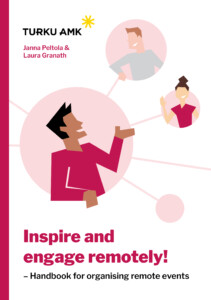Organising remote events
Remote events are part of the modern world and working life. There are a lot of similarities but also differences between remote events and traditional, face-to-face events. From the organiser’s point of view, it is important to identify the benefits and challenges of remote events. However, organising remote events can feel challenging if you are not used to it. The materials below support new actors to organise an activating and interactive event.
Inspire and activate remotely! The handbook provides practical ideas and guidance, especially for those who are interested in organising remote events or who already have some experience with the subject. The handbook explores the organisation of remote events, especially from the perspectives of inclusion and interaction. It leads the reader through the stages of organising a remote event and different ways to increase the networking of participants.
The handbook can be read and downloaded in English and Finnish. Check it out here:
The remote event has many names: webinar, online event, e-event, and so on. Although the event is held online, you can build it into an activating and interactive one. The DigiMESH project has organised a variety of events, from which event concepts have been created.
The Fast Track to Familiarity methods contain various exercises and tasks that the organiser can use to promote networking and mutual interaction between event participants. The cards provide ideas for both remote and live events.
Event models provide ideas for remote events organised in cooperation with companies. The templates include descriptions of the basic idea of the events, the implementation of the DigiMESH project, and the successes and stumbling blocks of the implementation.
Event models and methods can be modified to suit your own needs. Get inspired and give it a try!
Fast Track to Familiarity methods that promote interaction and networking in digital events
Event models for collaboration with companies and employers

